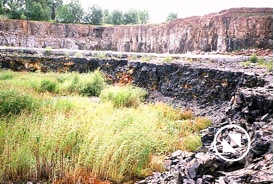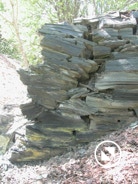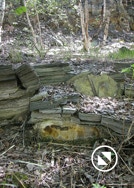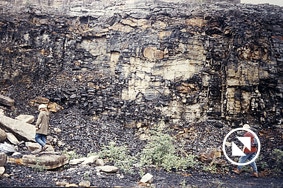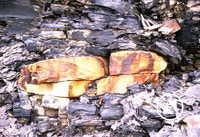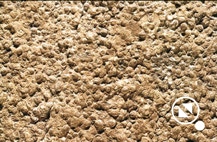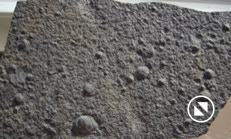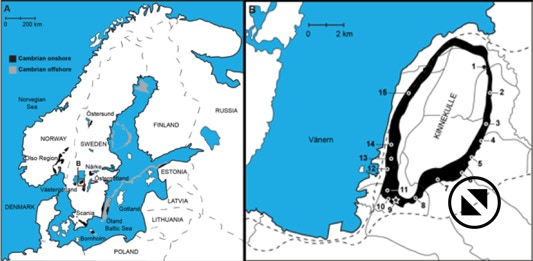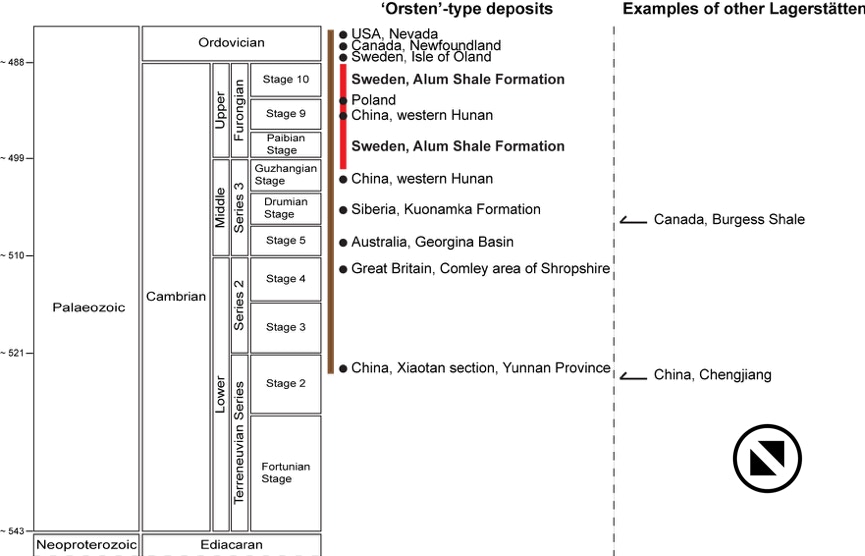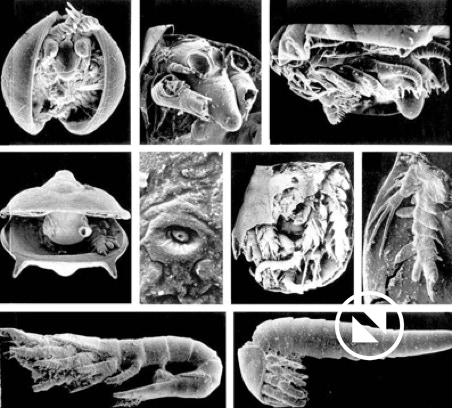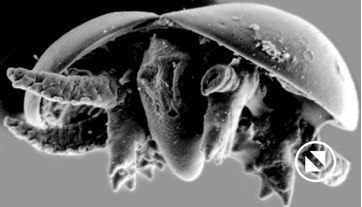Introduction to our 'Orsten' Research - Part 1
1. 'Orsten', historical and current meaning
Historical meaning
Horizontally laminated limestone nodules, called orstenar, occur embedded within bitumen-rich (black) shales, the Alum Shales of the upper part of the Cambrian in Sweden (now uppermost Middle Cambrian – formerly zone 1 Agnostus pisiformis to the Furongian – formerly zones 2 to 6 = Peltura scarabaeoides of the UC sequence). Alum shales occur first in the lower Cambrian and point to a relative stagnant water body with organic (detritus) rich bottom zone. The nodules are actually an accumulation of countless disarticulated calcitic head and tail shields of the minute arthropods, agnostids, in the lower zone exclusively made of Agnostus pisiformis (Wahlenberg, 1818). Due to the content of organic matter, the nodules can be brownish or very dark.We will add more on these in due course, with special reference to the new finds in China.
Left: Quarry near Falbygden, Västergötland, Sweden. Exposed are the Furongian and Lower Ordovician. Lower part with black, organic-rich alum shales (alunskiffer in Swedish), topped by a hiatus of 0.5 m, and 1–1.5 m mudstones forming the basis of the Tremadocian (Ceratopyge shales). Above, banked Ordovician limestones (Latorp limestone). 'Orsten' nodules within the shales. In this region, post-Cambrian dolerite caps have protected the less erosion resistant Alum Shales and other Palaeozoic strata, forming the characteristic table mountains ("Tafelberge") of Västergötland, most notably Kinnekulle. Photograph: Dieter Waloszek 1989 – site now "destroyed" due to recreation activities after the quarry had been expired.
Left middle: The surrounding alum shales, as here from a quarry in Skåne, Sweden, are a finely layered compaction series of up to 100 m – mostly much less – of bituminous shale with a notable heavy-metal content (see e.g.: Buchardt, B. 1989. Irradiation of organic matter by uranium decay in the Alum Shale, Sweden. Geochimica et Cosmochimica Acta 53(6),1307-1322.).
Right middle: Large Orsten nodule surrounded by alum shales at the northern edge of the famous Gum quarry at the Kinnekulle, Västergötland, Sweden (photo DW, 2004).
Right: Falbygden quarry again, closer view of the many nodules embeed within the shales.
Left: Orsten' nodule embedded within alum shales (same quarry as above). Often the nodules are surrounded by a crystallitic crust of limestone.
Center: Surface of a fractured nodule with countless number of agnostid shields. Often these are sorted (dot = 5 mm). Walnut-size pieces of this rock have been dissolved to receive the non-calcitic content.
Right: Dark bitumen-rich nodule with different trilobites and agnostid shields.
The name 'orsten' derives from a local dialect word for pig, 'orne' and the Swedish word for stone, 'sten'. It is assumed that the name derives from the use of ground 'orsten' as veterinary medicine for domestic pigs. It is often translated to 'stinkstone' due to the characteristic smell ("rotten eggs"), when struck or split. The nodules were also burnt to produce fertilizer. Most Alum Shale and 'Orsten' quarries are now abandoned. Nowadays, nodules are frequently uncovered in the Falbygden area, Västergötland, along roads when newly constructing them. More finds were from the Isle of Öland and in Skåna, but there no 'Orsten-type' fossils were found.
Above: Occurrence of 'Orsten' rock in Scandinavia (left) and around the hill Kinnekulle at lake Vänern, Västergötland (from Castellani et al. 2018. (9) on right map: the famous locality Gum, now a nature reserve).
Below photograph of Dieter Waloszek from 2004, taken from the south. Distance Gum – Öland approx. 330 km.
New meaning
In the meantime the meaning of 'Orsten' changed so that today we understand by 'Orsten' a conservat lagerstaette yielding fossils, mainly tiny, in a special type of preservation, namely secondary three-dimensional preservation of the outer surface/cuticular layer of mainly arthropods and nemathelminth worms (only particular regions), recently also holding for cyanobacterial threads, their outer sheets being preserved. In the same way, when talking about 3D-preserved animals from 'Orsten' localities we talk of 'Orsten' fossils or 'Orsten' fossil assemblages or biota.
Orsten fossils are rare but widespread
According to our experience, only very few of the Swedish 'Orsten' nodules we collected yielded phosphatized arthropod remains. In fact, only two nodules from the Gum quarry at Kinnekulle, Västergötland, yielded the bulk of our material. Most of the nodules, representing a time frame of at least 1 million years, have yielded few to single specimens, if at all.! Accordingly, it is unlikely that the fossils represent an allochthonous thanatocoenosis or have been killed in a event comparable to stagnant, anoxic conditions at certain times during a year, as occurring today in the Baltic Sea sometimes or in the Mediterranean Sea. More or less they represent the very rare event of preservation – such as the Ötzi in a glacier in the Alps.
After etching the nodules by using a mild acid (10%ic acetic acid), the non-calcitic residues remain (on the sieves in the buckets). The residues contain silicified fossils, such as sponge spicules (but no grains indicative of sandy components), coarser phosphatic matter and phosphatic or phosphatized fossils. Some can be assigned to so-called "small shelly" fossils = minute fossils, parts or entire, of unclear affinities , (primarily phosphatized) conodonts, shells of (primary?) phosphatic brachiopods (mainly Obolus – and secondarily phosphatized remains of arthropods. Klaus Müller, originally interested in the conodonts in the nodules, concentrated in his projects funded by the German Research Foundation, on arthropod remains. Subsequently information increased and the views changed accordingly. Particularly the new finds outside Sweden demonstrated larger differences between the various types of rock that yield 'Orsten' preservation than previously expected to yield 'Orsten' fossils. The time table of major localities through time that yielded fossils in 3D preservation demonstrates two aspects: 1) the remarkable amount in the Early Palaeozoic, and, 2) the wide geological record of the Orsten. More in one of the next chapters.
Timescale with 'Orsten'-type finds: brown, total range; red, Swedish occurrences.
2. What are 'Orsten'(-type) fossils?
'Orsten' fossils are minute and secondarily phosphatized (calcium fluor phosphate = apatite, like in our teeth) bodies of in the main arthropods including their outgrowths – eyes, appendages, membranes etc., altogether called "soft parts". This phosphatization seems not to have affected the sclerotic parts of a cuticle, not the chitinous layer anyway, but the outermost layer at least of arthropods, the epicuticle. This layer contains lipoproteids and serves as protection and boundary against water, so is hydrophobic. It is also the layer that produces the finest details such as bristles, wrinkles on membranes or pits preserved in 'Orsten' fossils. If only deeper parts would be preserved one would have much more coarsely preserved fossils. Remarkably, the best preserved and most complete specimens are the smallest, ca. 100 µm long, while of larger forms we have only fragments at hand. Remarkably, we did not find any fossil fragment larger than 2 mm in the Swedish material, even when the animal could be reconstructed to be longer.
Left: Examples of arthropod fossils in 'Orsten'-type preservation; Right: Fossils as living animals
Until now the majority of arthropods described has been affiliated with the Crustacea, in more detail identified as representatives of different evolutionary levels. Also other arthropods were discovered ranging from a representative of another euarthropod groups, the spider group, Chelicerata, to representatives of all three offshoots of the early arthropod lineage, pentastomids, tardigrades and lobopodians. More recently, also fossils of representatives of a group of worms, the Nemathelminthes considered as the sister taxon to all other gastroneuralian animals (those with ganglial "brain" and (also ventral) nerve strands through the body) were found. This includes even so-called embryonic stages of a form named Markuelia, but are almost finished worms within a much developed egg shell.
On the other hand, no "soft parts" of other animal groups could be detected so far, also not the smallest bit of trilobites, which are, otherwise, common in the rock. The 'Orsten' rocks as a whole contain also many other fossils, phosphatic and not phosphatic, such as conodonts or the so-called small shellies, "horny" = primarily phosphatized brachiopods, and there are also shelly = calcitic fragments of macrofaunal elements in surrounding rocks, such as agnostids, brachiopods and trilobites, but we do not count these as 'Orsten' fossils because of the lack of cuticular preservation, i.e. lack any softparts, but only calcified exoskeletal parts – shields and shells – and even if some of the fossils are 3d-preserved. The exception is the rock-forming Agnostus pisiformis of which the rock contains calcitic shields, while we have more than one hundred specimens of different immature stages with cuticular preservation = softparts.
As said, 'Orsten' fossils have the great advantage in being three-dimensionally preserved and with all surface structures in place, their morphological order. Accordingly, they are much easier to interpret than any other fossil material. In fact, 'Orsten' fossils are preserved virtually as if they were just critical-point dried living organisms. Details range down to less than 1 µm and include pores, sensilla or minute secondary bristles on filter setae, spines and denticles, in rare cases even facets of so-called compound eyes. 'Orsten' fossils are, generally, small, i.e., smaller than one centimeter, therefore give an insight of benthic life at small scale, hence including also animals of the small-size life zone or meiofauna. Therefore, it is not surprising that our material contains also many ontogenetic stages, down to the earliest larvae hatching from an egg. In some cases, we were able to establish sets of successive stages, the longest being that of Rehbachiella kinnekullensis with 30 stages. From larger fragments we even know that this series is still not complete. Possibly due to impregnation by phosphate, most of the specimens are hollow carcasses, but some specimens may also be completely solid, the reasons of it are still unknown.
Fossils in a similar 3D phosphatic preservation range from embryonic stages (e.g., early cleavage in various late Precambrian to Lower Cambrian rocks to arthropods in much younger sediments; examples are Triassic ostracodes from Spitsbergen or Lower Cretaceous ostracodes and parasitic copepods from the Santana formation, Brazil. 3D silification is another unusual type of preservation of arthropods, known from, e.g., the Tertiary (Neogene), having preserved crustaceans, spiders and insects including immature stages, similar to the 'Orsten'.
In this Section...
© 2020 CORE


